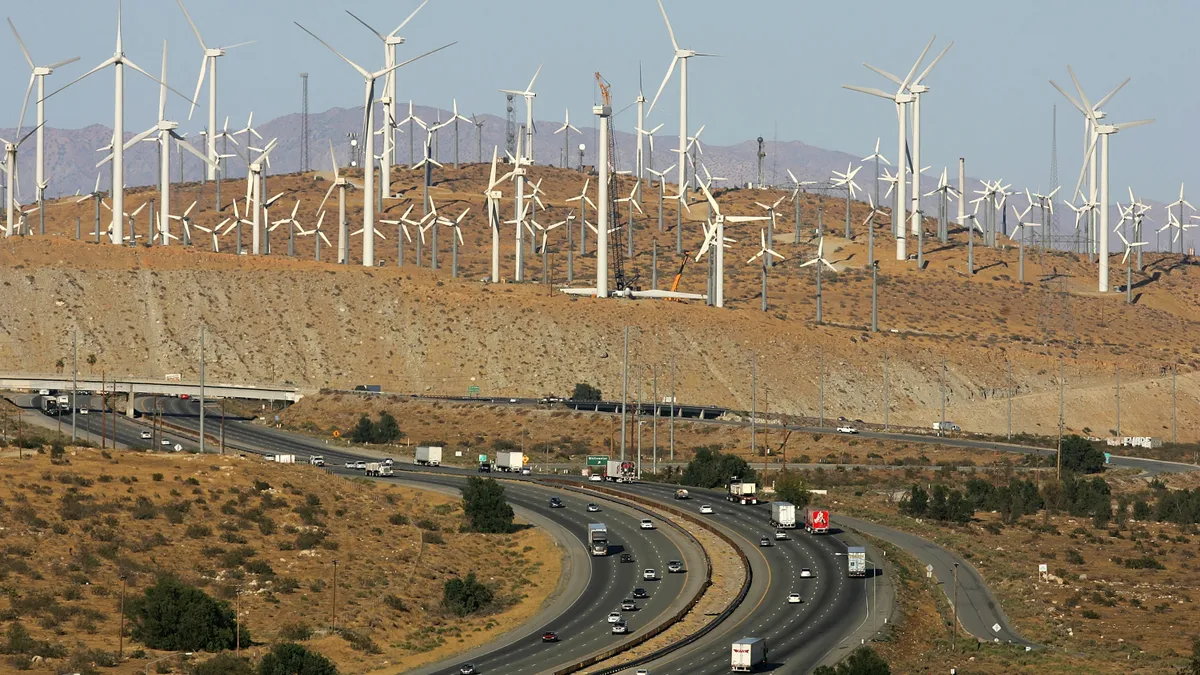Dive Brief:
- Ensuring a reliable grid and affordable energy remain key priorities for California's utilities as the state charts a path toward its goal of 100% renewable and zero-carbon electricity by 2045, power providers said during a joint agency workshop Wednesday.
- The meeting, conducted by the California Public Utilities Commission (CPUC), California Energy Commission and California Independent System Operator (CAISO), kicked off a broader regulatory process to begin planning for the build out of new resources to meet that goal.
- "Making sure that reliability in the near term and the longer term continues to be the focus as we decarbonize is a very critical part and priority of this journey," Daniel Hopper, director of resource and environmental planning and strategy at Southern California Edison, said. "[W]e are at an inflection point. The old ways of planning simply don't work," he added.
Dive Insight:
California passed SB 100 in 2018 outlining its 2045 clean energy goals, as well as requiring the state's energy agencies to compile reports every four years evaluating ways to get there. Earlier this year, state energy agencies released the first such report, which concluded that the state will need to build new generation capacity at a record-breaking rate over the next quarter century — an average of up to 6 GW of new renewable and storage capacity per year, compared to the 1 GW of utility solar and 300 MW of wind per year that the state has built on average over the last decade.
Regulators are simultaneously tackling the need to ensure grid reliability, an issue thrown into the spotlight during last August's blackouts. Looking out to the middle of the decade, California is also figuring out how to replace the retiring Diablo Canyon nuclear facility, as well as a suite of natural gas plants.
"We do see the industry at a critical inflection point, where the amount of new resources that are needed to be added to the grid, the pace of that development needs to be considerably accelerated," Neil Millar, CAISO's vice president of transmission planning and infrastructure development, said at the workshop.
Utility representatives at the meeting agreed that reliability considerations are a top priority for them.
"California has been a leader in decarbonization and continues to be one, including the decades of energy efficiency and renewables investments we've made — how do we also ensure we're a leader in making sure we're planning for reliability as the grid changes?" Hopper said.
Pacific Gas & Electric (PG&E) also identified the reliability of the grid and energy supply as a key priority. PG&E anticipates that decarbonized gas-fueled generation resources will be required in the long run to ensure peaking capability, the utility's director of energy strategy and innovation, Jan Berman told regulators. As California's current fossil generation fleet begins to retire, these plants will be replaced by new generation that could include some combination of hydrogen, renewable natural gas and possibly fossil fuels combined with carbon capture and storage, she added. Utilities can also enable customers to support reliability by structuring rates that align load and the use of distributed energy resources with grid needs, Berman said.
California's definition of "zero-carbon" should include the combustion of renewable natural gas, green hydrogen, and natural gas combined with carbon capture and sequestration, said Jeff DeTuri, policy and strategy manager with San Diego Gas & Electric. He urged regulators to include reliability assessments in the modeling around California's 100% clean electricity goal, and to conduct this modelling more frequently than every four years.
Dawn Weisz, CEO of community choice aggregator MCE, said the state needs to find solutions for reliability that allows it to "unhook from fossil fuels." Current systems make it difficult and sometimes impossible to purchase and use some of the no-carbon solutions that are emerging, Weisz added — for instance, there isn't a clear way for renewable hydrogen to qualify as a reliability resource under existing rules.
"While a lot of these technologies are promising and probably essential to helping us meet SB 100 goals, the mechanics need to be figured out before contracting for these resources can actually occur," she said.
Alongside reliability, power providers also emphasized the need to ensure that energy remains affordable as California navigates its broader clean electricity transition.
"We need to make sure the cost of implementing these new technologies isn't borne by customers — especially our most vulnerable customers," Weisz said.
Customers are a foundational part of reaching decarbonization goals, Hopper agreed, and it will be increasingly difficult if electric system costs become barriers to decarbonization and electrification.
"Affordability is definitely a key area here," he said.














